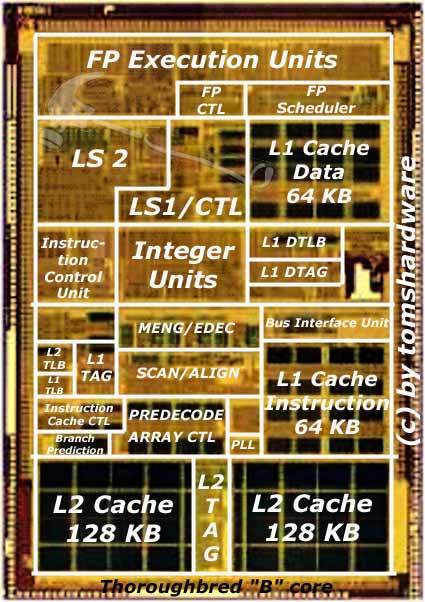AMD Travels Through Time: Athlon XP 2800+ with Dual-DDR
New CPUs, Old Boards: Athlon XP 2800+ Starting From KT333
The latest Athlon XP CPUs, 2700+ and 2800+, only work with boards that have a 166 MHz FSB clock. This means that your only choices are VIA KT333, KT400 or SiS 746. Older motherboards with VIA KT133A, KT266, KT266A or SiS 735 won't work with the new Athlon XP processors. On the one hand, the FSB clock is not supported with these boards, and on the other hand, the power of the voltage converter is not enough for operation.
All in all, we have a situation that is similar to that of Intel's P4: backwards compatibility is limited. Furthermore, you have to ask whether it makes sense to run an old KT133A board and SDRAM (PC133) with an Athlon XP 2800+ and hope that you're lucky.
Copper Interconnects In Nine Layers
Architecture of the new Thoroughbred "B" core.
A modern CPU, such as the AMD Athlon XP or Intel Pentium 4, consists of transistor layers (silicon) and several interconnect layers. Ever since it introduced the Athlon with the Thunderbird core and six interconnect layers, AMD has been continually increasing the number of layers. The Palomino core followed with seven layers, because the SSE logic and the optimized cache lines required a greater number of interconnects. The next step came about with the Thoroughbred "A," which had an eighth layer. With the shrinking of the circuit paths and the distances between them from 0.05 micron to 0.13 micron, and with the new component layout, further interconnects were required.
The Thoroughbred "B" holds the current record with a total of nine copper interconnect layers. Compared to the Thoroughbred "A" with eight layers, the introduction of this new layer involves completely new interconnects. The result is an increased number of circuit paths: the conductivity of the connections within the processor is increased, and thus the thermal dissipation is automatically reduced. In addition, AMD has thrown in further capacitors in order to significantly reduce transistor interference that results from the combination of the interconnect layers and capacities at high clock speeds.
View of the interconnect layers in modern processors (here, the P4 Northwood is shown).
To sum up: the resistances between the transistors have increased (crosstalk effect). In order to differentiate between the two types of Thoroughbred cores, AMD has added an extra "B" to the label for the new CPUs. In the future, AMD plans to introduce the SOI technique for the first time with its Barton core. Processors manufactured with SOI technology are supposed to be able to process signals faster and with less thermal dissipation, achieving up to 35% higher clock speeds with the same dissipation.
Get Tom's Hardware's best news and in-depth reviews, straight to your inbox.
Current page: New CPUs, Old Boards: Athlon XP 2800+ Starting From KT333
Prev Page Details On The Test Boards, Continued Next Page History: Protection Against Thermal Death
